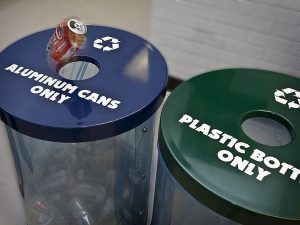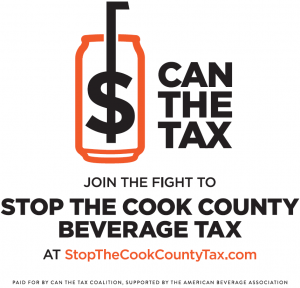
“22 million pounds of plastic flow to the Great Lakes each year”
Chicago’s early January temperatures don’t make for beach-going, but beaches free of plastic litter were recently top of mind for Illinois Great Lakes advocates.
As a national law passed in 2015 banning microplastics went into effect, three Illinois groups turned their attention to broader plastic issues including beach litter.

Jennifer Walling, Executive Director Illinois Environmental Council, courtesy of ilenviro.org
The Illinois Environmental Council, the Alliance for the Great Lakes and Chicago’s Shedd Aquarium in a press release called on elected officials, businesses and citizens to “pass on plastic whenever possible and help reduce plastic pollution in the Great Lakes.”
“About 22 million pounds of plastic flow into the Great Lakes each year,” the Illinois Environmental Council’s Jennifer Walling said in the release. The Alliance for the Great Lakes reported that 80 percent of the beach litter its volunteers pick up is plastic.
But beach-sweeps are reactive and the Alliance’s Joel Brammeier said that “true solutions focus on the sources of plastic pollution…”
Solutions
Perhaps Grand Haven, Michigan’s beach experience points to a solution; refundable deposits on soda in plastic bottles and bottled water in plastic.
City Manager Patrick McGinnis told Great Lakes Now that Grand Haven is an “activist city” when it comes to beach trash and that bottled water is a litter problem but empty bottles of soft drinks like Coke and Pepsi aren’t.

Recycling program containers, courtesy of NASA/Sean Smith
“Single use sodas are not an issue because of Michigan’s refundable deposit law,” McGinnis said. “Beachgoers don’t leave them behind. However, bottled water is exempt from the law as it only applies to carbonated beverages,” according to McGinnis.
Nestle Water in Michigan is currently requesting a permit to increase bottled water production.
And the Great Lakes Compact designed to keep water in the basin contains language known as the bottled water loophole. It allows water in containers less than 5.7 gallons to be shipped out of the basin.
McGinnis said Grand Haven hasn’t considered a bottled water ban and it would have to be researched for compliance with existing laws.
Chicago’s aversion to recycling
In Chicago, Park District spokesperson Jessica Maxey-Faulkner told Great Lakes Now the district has “not made specific efforts to ban plastic” on beaches.
“Each summer as we begin our beach season we do so with the introduction of anti-littering campaigns and reminders to our patrons of the damage that littering does to our beautiful beaches,” she said.
“Our beaches offer both recycling and trash receptacles throughout. Patrons have more than enough opportunities to clean up after themselves.”
But will they?
After the 2016 Memorial Day weekend Chicago’s North Avenue Beach was so littered it caused a visiting tourist to tell a television reporter, “we’ve been to a lot of beaches in the world and this is the trashiest one we’ve ever seen.”
Perhaps Chicago’s historic aversion to recycling provides insight to why it would trash its most popular beach.
Chicago’s city-wide recycling rate is 9.7 per cent, one of the lowest rates in the nation. That begs the question- does the Great Lakes region’s biggest city lack a recycling ethic?
Chicago Tribune editors wrote last year that “Chicago stinks at recycling,” chronicling the city’s failed recycling efforts going back to the 1990’s.
For perspective, Chicago’s neighbor to the North, Milwaukee, recycles 25 percent of its trash, Cleveland 14 percent and Buffalo 28 percent. San Francisco leads the nation in recycling with a whopping 80 percent.

John G. Shedd Aquarium in Chicago, courtesy of KEye
The Shedd Aquarium borders Lake Michigan and Its conservation officer, Cheryl Mell, told Great Lakes Now that in 2017 the aquarium eliminated single-use plastics like straws and utensils in its restaurants and provided recycling opportunities for visitors.
Shedd continues to sell bottled water and other single-use beverages in plastic bottles, but Mell said they have a “commitment to significantly reduce or eliminate single-use plastic beverage bottles by December 1, 2020.”
Mell said Shedd “would definitely support Chicago Park District in any effort to ban plastic use on our beaches.”
The Illinois Environmental Council’s Walling said the council supports “a range of proposals that would reduce plastic pollution including education, increased littering enforcement, fees, and bans of single use plastic material, as feasible.”

Can The Tax Printable Window Sign, courtesy of stopthecookcountytax.com
But any effort to tinker with beverage container laws in Chicago can be a tough sale as evidenced by the soda-specific tax increase implemented in Cook County, which includes Chicago. The tax was supposed to reduce consumption of sugary beverages with the increased revenue filling gaps in the budget.
The county was forced to repeal the tax after only two months following outrage from citizens and pressure from soda producers. It’s hard to imagine that a ban on single use plastic containers on beaches wouldn’t meet a similar fate.
That means controlling plastic beach litter hinges on self-policing of trash and recycling programs.
Back to microplastics.
Central Michigan University Professor Don Uzarski directs the Institute for Great Lakes Research and he supports efforts to keep plastic of all types out of the Great Lakes.
But he’d like to see more emphasis on the toxic pollutants that flow to the lakes.
Microplastics “impact organisms by concentrating the toxic pollutants already in the environment,” Uzarski told Great Lakes Now.
“At this point, a better focus of our attention would be on preventing the toxicants from entering the Great Lakes in the first place.” Uzarski said.
Note from Great Lakes Now Bureau Chief Mary Ellen Geist: Later this week on greatlakesnow.org, you’ll see an interview with a scientist who explains more about microplastics and their impact on the Great Lakes.
3 Comments
-
While the image of the Albatross is a powerful one it should not be associated with this article, and I doubt you have permission from the artist Chris Jordan. This series was taken of birds in the Pacific Ocean far away from the Great Lakes. Please consider rectifying your miss categorization, or at least giving credit where credit is due.
-
Thanks @Laura Minor – it is a powerful image. Photo credit in Alt tag – but we’ll add here as well. Photo via Wikimedia Commons – Chris Jordan (via U.S. Fish and Wildlife Service Headquarters) / CC BY 2.0
-
-
I just wish more people paid attention to this growing crisis the world is facing. Our leaders need to take more action! Maybe one day a bill will make all facilities recycle or limit their paper/plastic intake…




